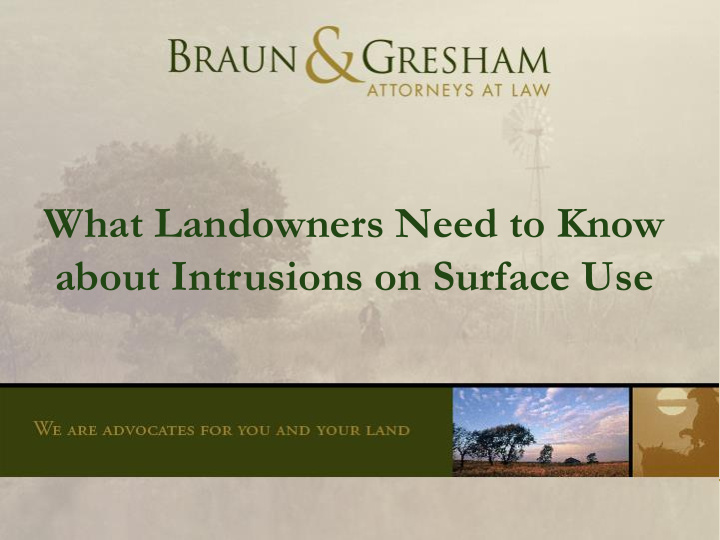



What Landowners Need to Know about Intrusions on Surface Use 1
Big Picture • Phase 1: Company or agency study • Engineering, environmental, etc. • Phase 2: Routing • Phase 3: Land acquisition (condemnation) • Phase 4: Construction 2
Phase 2: Routing 3
Routing Process Transmission/Pipelines/Roads • Regulated Formal Process – Powerline Company Files CCN – Heard by SOAH/PUC • Non-regulated Informal Process – O&G Company/Water Corp/Railroad/TxDOT – Not regulated by RRC/TCEQ/OAG
Powerline Critical Fact! “RECOMMENDED ROUTE” MAY NOT MEAN MUCH 5
Powerlines in SOAH • Intervene or Comment? • If Intervening, Provide Written Direct Testimony • Critical Difference: Protestors are Not Parties and Comments Are Not Evidence 6
Roles and Strategies of the Team Experts: Landowners: Lawyers: Routing Alliances Legal 7
How Experts Can Help You • Analyze Routes and Segments • Recommend a Route • Support or Rebut Routes Chosen By Routing Agency • Provide Testimony at Hearing 8
Critical Conclusion! “INTERVENORS” INFLUENCE ROUTE SELECTION 9
10
11
Big Picture • Phase 1: Company study • Phase 2: Routing • Phase 3: Land acquisition (condemnation) • Phase 4: Construction 12
Steps in Eminent Domain/Condemnation • Phase 1: The Call, Visit or Letters from Landman • Phase 2: Negotiating Your Terms and Compensation • Phase 3: Special Commissioners’ Hearing • Phase 4: District Court/County Court at Law Appeal 13
Phase 1: The Letters • “Bona fide offer” required • Condemnor’s “initial offer” • Generally, includes a 30-day deadline • Law requires a written appraisal and 14-day “final offer” before any hearing • Critical time to have consulted with an attorney 14
Phase 2: Negotiating Your Terms & Compensation • Company landman makes the written offer • First offer typically “low” • Offer and terms are negotiable • Landman and/or company lawyers discuss price, location, and terms 15
16
17
18
19
20
21
22
Market Value - Easements/Fee Take • Total compensation = – Value “Before” minus Value “After” • Value of the “Take” (permanent easement or fee) • “Remainder” damage, if any, is compensable 23
Landowner ’ s Appraiser ’ s COMPENSATION SUMMARY Market value of Land: $1,025,000 Market Value of Improvements: $515,000 Market Value of Whole Property Before Taking: $1,540,000 Market Value of Whole Property After Taking: $1,220,753 Compensation Damages (Loss in Value): $319,247 Oncor Easement Acquisition: $9,901 Temporary Construction Easement: $3,430 20% Damages to the Remainder: $305,916 COMPENSATION: $319,247 24
Utility’s Appraisal $36,622 vs Landowner's Appraisal $319,247 25
Phase 3: Special Commissioners • If no agreement, company files condemnation lawsuit • Purpose of Special Commissioners is to assess damages and “award” a dollar amount to landowner • Braun & Gresham continues to negotiate • Company can start construction after deposit of award 26
Phase 4: Appeal • Objection to award • Formal courtroom jury trial • Decides price • Expensive • Should be used as last resort 27
General Negotiations • Price of land taken • Other damages • Details of routes • Location of facilities • Temporary agreements – e.g., Roads/Easements • Permanent easements 28
Easement Negotiations • Restore/protect land • Access points • Roads • Improvements • Fences and gates • Liability protections • Landowner’s future use • Limits on others’ use 29
Pipeline Specific Negotiations • Non-exclusivity • Limitation of number of lines • Limitation of diameter of pipe • Limitation of easement width • Limitation of surface facilities • Depth of pipe • Surface restoration measures • Indemnity protection • Termination clause • Land/ranch specifics • Miscellaneous provisions – No warranty, dispute resolution, etc. 30
Bad Old Easements • “Blanket” easements • Undefined ingress and egress locations • Undefined width of permanent easement • Undefined number and sizes of pipelines • Undefined number of transmission line circuits, etc • Undefined use of additional temporary work space • Payment for new lines at 1930’s prices -- or worse!! 31
32
33
Exceptions to Title Policy • Buyer should request the documents and carefully review the language before closing • Without a careful review by buyer and his/her attorney, the buyer man not realize the extent of the burden of a bad old easement` • Company may decide to “maintain” an old easement and remove all trees/growth in a 50-100 foot strip of land -- or lay additional lines anywhere on the property 34
35
QUESTIONS? • Do transmission lines/pipelines negatively/roads affect property values? • Should the seller tell the buyer: – an electric utility company has notified the seller the property may be impacted by the routing of a new transmission line? – a pipeline company has notified seller about the possible routing of a new pipeline across the seller’s property? – TxDOT, etc. has notified seller about the possible routing of a new road near or across the seller’s property? • Sale of property that is under threat of potential condemnation? 36
Q & A 37
Stay informed and connected Like us on Facebook Facebook.com/BraunGresham Follow us on Twitter Twitter.com/BraunGreshamLaw Join our Landowner Alert System www.braungresham.com/contact-us/#contact
Patrick L. Reznik Attorney, Counselor, Mediator Braun & Gresham, PLLC preznik@braungresham.com www.braungresham.com A family of companies proudly serving the owners of rural land.
Recommend
More recommend